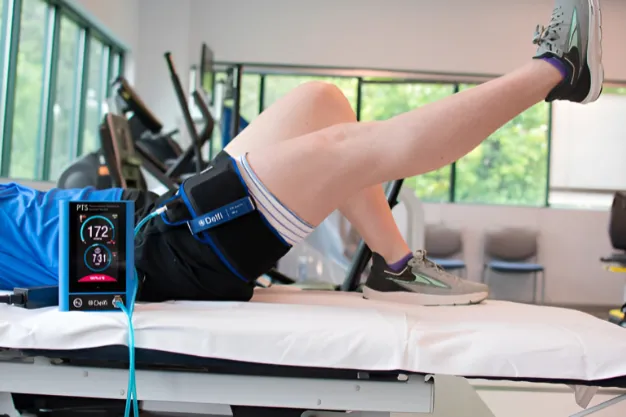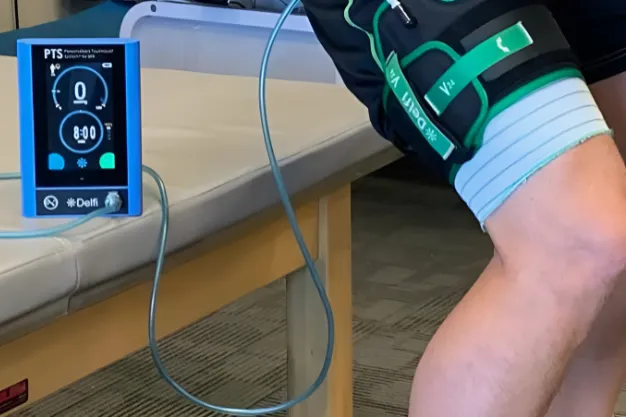Dynamic Physical Therapy
Blood Flow Restriction in Cottonwood Heights, UT

Revolutionize Your Recovery: Advanced Blood Flow Restriction Therapy
Blood flow restriction (BFR) therapy is an advanced rehabilitation technique that enhances muscle strength and recovery while using lighter weights. This specialized tourniquet system allows patients to build strength quickly while using low loads, making it particularly valuable during the early phases of post-operative rehabilitation or when joint protection is crucial.
We use Delphi PTS and it is the only FDA approved BFR system. Our commitment to safety and efficacy means you receive treatment with the most trusted technology in the field. The Delphi PTS system provides precise, personalized pressure control based on your unique physiology, ensuring optimal results while maintaining the highest safety standards. This medical-grade technology allows our specialists to customize your treatment protocols with accuracy unavailable with other BFR methods, giving you confidence that you’re receiving the gold standard in blood flow restriction therapy.
This method is ideal for individuals recovering from injuries, those in post-surgical rehabilitation, or patients unable to tolerate heavy resistance training. By carefully controlling blood flow to specific muscle groups, BFR therapy enables significant strength gains without placing excessive stress on healing tissues or compromised joints.
Blood flow restriction (BFR) therapy, also known as occlusion training, is an innovative rehabilitation and exercise technique that involves using specialized bands or cuffs to partially restrict blood flow to specific muscle groups during low-intensity exercise. This method was originally developed in Japan, where it was called KAATSU training, and has since gained popularity among athletes, physical therapists, and fitness enthusiasts worldwide. The fundamental principle behind BFR therapy is that by limiting blood flow to working muscles while exercising at relatively low intensities (20-30% of one’s maximum capacity), you can achieve similar strength and muscle growth benefits as traditional high-intensity training.
The physiological mechanisms behind BFR therapy are complex and multifaceted. When blood flow is partially restricted, metabolic stress increases in the targeted muscles, leading to the accumulation of metabolic byproducts like lactate and hydrogen ions. This metabolic accumulation, combined with the hypoxic (low-oxygen) environment created by the blood flow restriction, triggers a cascade of cellular responses that enhance muscle protein synthesis and promote the release of growth hormones and other anabolic factors. Additionally, the restricted blood flow causes preferential recruitment of fast-twitch muscle fibers, which are typically only activated during high-intensity exercise.

Delphi PTS is the only FDA approved BFR system.
While BFR therapy has shown promising results in various applications, from post-surgical rehabilitation to athletic performance enhancement, it’s crucial to note that proper implementation requires careful consideration of several factors. The pressure applied must be precisely controlled – too much pressure can be dangerous, while too little won’t produce the desired effects. The cuffs or bands must be appropriately sized and positioned, and the duration of restriction must be carefully monitored. For these reasons, it’s recommended that individuals interested in BFR therapy work with qualified healthcare professionals or certified practitioners who can properly assess their needs and safely guide them through the protocol.
How Blood Flow Restriction Therapy Works
Blood flow restriction therapy utilizes specialized pneumatic cuffs or tourniquet-style bands that are strategically positioned around the proximal portion of the limbs (upper arms or upper thighs) to achieve partial blood flow restriction. These devices maintain about 60-80% of normal arterial blood flow while limiting venous return, creating a pooling effect in the working muscles. This controlled restriction is carefully calibrated based on individual factors like limb circumference and blood pressure, typically ranging from 40-80% of the pressure required for complete arterial occlusion, ensuring the creation of an optimal metabolic environment while maintaining safety.
The physiological cascade triggered by BFR is a complex interplay of multiple mechanisms that drive muscle adaptation. When blood flow is partially restricted during exercise, the hypoxic environment forces the early recruitment of high-threshold motor units and fast-twitch muscle fibers – a pattern typically only seen during high-intensity training. Simultaneously, the limited venous return causes metabolites to accumulate in the muscle tissue, creating a potent metabolic stress signal. This combination stimulates the release of growth hormone, insulin-like growth factor-1 (IGF-1), and other anabolic hormones at levels comparable to or exceeding those seen with traditional high-intensity resistance training.
At the cellular level, BFR training activates crucial pathways for muscle growth and adaptation while minimizing joint stress and mechanical strain. The metabolic stress activates the mechanistic target of rapamycin (mTOR) pathway, a key regulator of muscle protein synthesis, while also enhancing satellite cell activation and proliferation. The hypoxic environment leads to increased expression of hypoxia-inducible factor-1 alpha (HIF-1α), promoting angiogenesis and improved nutrient delivery to trained muscles. When properly implemented with appropriate pressure control and exercise protocols, these physiological responses can be achieved using relatively light loads (20-30% of maximum capacity) and short session durations of 15-20 minutes.
Benefits of Blood Flow Restriction Therapy
1. Strength and Muscle Growth Without Heavy Lifting
- Enables strength and muscle gains using only 20-30% of normal training loads
- Reduces stress on joints and connective tissues
- Effective for those recovering from injuries or surgeries
2. Shorter, More Efficient Workouts
- Increases muscle activation with fewer reps
- Reduces overall workout time while maintaining effectiveness
- Allows faster rehabilitation and return to activity
3. Customized Programs for Different Needs
- Tailored for post-surgical recovery, injury rehabilitation, and athletic performance
- Adjusted based on individual goals and progress
- Suitable for a wide range of fitness levels
Frequently Asked Questions
How does BFR promote muscle growth?
BFR mimics the effects of heavy lifting by restricting oxygen availability, creating metabolic stress that triggers muscle adaptation and growth.
Is BFR safe?
We use the Delphi PTS that is the only FDA approved device the ensures safety and protection of the nerves in the area being compressed. When applied correctly under professional supervision, BFR is a safe and effective therapy. Sessions are closely monitored to ensure proper blood flow restriction levels and exercise progression.
How long does a BFR session last?
Typical sessions last between 15-45 minutes, depending on the individual’s needs and training experience. Cuffs are deflated between sets to restore circulation.
Meet Your Blood Flow Restriction (BFR) Therapy Team
At Dynamic Physical Therapy, we offer advanced Blood Flow Restriction (BFR) therapy to enhance strength gains and accelerate recovery with less stress on healing tissues. This specialized technique allows for significant improvements in muscle strength and size while using lighter weights, making it ideal for post-surgical rehabilitation and recovery from injuries.
Matthew Nelson PT, DPT, TPS, AFDNS, AIB Cert – VR
Matt implements BFR therapy as a key component in his sports rehabilitation protocols, particularly for patients recovering from injuries who cannot tolerate heavy loading. His expertise in pain management and sports medicine allows him to precisely apply BFR principles to accelerate recovery while protecting healing tissues. Matt finds this approach particularly valuable for his baseball athletes and golfers looking to maintain strength during rehabilitation from elbow, shoulder, and knee conditions.
Jessica Bauerkemper PT, DPT, AIB CERT – VR
Jessica utilizes BFR therapy in her post-operative rehabilitation programs to minimize muscle atrophy and promote strength gains when traditional resistance training isn’t possible. Her orthopedic expertise guides her application of BFR for patients recovering from joint surgeries and tendon repairs. Jessica’s integrated approach combines BFR with her comprehensive rehabilitation strategies to help patients achieve functional milestones more quickly during recovery.
Anika Jansen, PT, DPT
Anika incorporates BFR training for patients with chronic tendinopathies and those recovering from lower extremity injuries. Her specialized approach allows active individuals to maintain conditioning while reducing stress on injured tissues. Anika’s background working with trail runners and outdoor enthusiasts informs her application of BFR to address specific strength needs while supporting continued participation in modified activities during recovery.
Ciena Lavallee PT, DPT, Cert. MDT
Ciena strategically implements BFR therapy within her rehabilitation programs for patients requiring strength development without excessive loading. Her experience as a triathlete gives her unique insight into utilizing BFR for endurance athletes recovering from overuse injuries. Ciena combines BFR with her McKenzie Method expertise to develop comprehensive rehabilitation programs that simultaneously address mechanical dysfunction and strength deficits for optimal recovery outcomes.
Start Your Recovery
BFR therapy is a proven way to rebuild strength, enhance mobility, and accelerate recovery. Contact Dynamic Physical Therapy today to schedule a consultation and learn how this innovative therapy can support your rehabilitation and performance goals.

